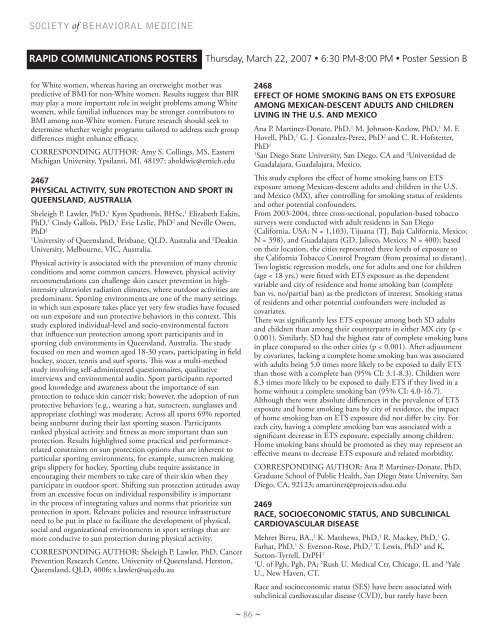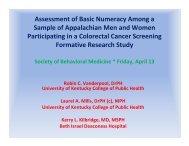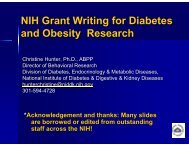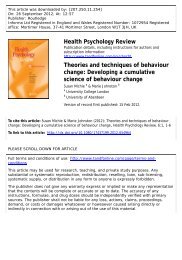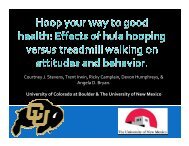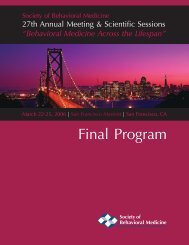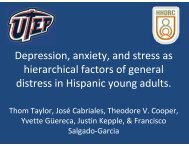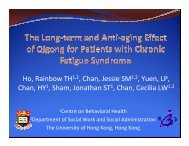2007 Final Program - Society of Behavioral Medicine
2007 Final Program - Society of Behavioral Medicine
2007 Final Program - Society of Behavioral Medicine
You also want an ePaper? Increase the reach of your titles
YUMPU automatically turns print PDFs into web optimized ePapers that Google loves.
SOCIETY <strong>of</strong> BEHAVIORAL MEDICINE<br />
Rapid Communications Posters Thursday, March 22, <strong>2007</strong> • 6:30 PM-8:00 PM • Poster Session B<br />
for White women, whereas having an overweight mother was<br />
predictive <strong>of</strong> BMI for non-White women. Results suggest that BIR<br />
may play a more important role in weight problems among White<br />
women, while familial influences may be stronger contributors to<br />
BMI among non-White women. Future research should seek to<br />
determine whether weight programs tailored to address such group<br />
differences might enhance efficacy.<br />
CORRESPONDING AUTHOR: Amy S. Collings, MS, Eastern<br />
Michigan University, Ypsilanti, MI, 48197; aholdwic@emich.edu<br />
2467<br />
PHYSICAL ACTIVITY, SUN PROTECTION AND SPORT IN<br />
QUEENSLAND, AUSTRALIA<br />
Sheleigh P. Lawler, PhD, 1 Kym Spathonis, BHSc, 1 Elizabeth Eakin,<br />
PhD, 1 Cindy Gallois, PhD, 1 Evie Leslie, PhD 2 and Neville Owen,<br />
PhD 1<br />
1<br />
University <strong>of</strong> Queensland, Brisbane, QLD, Australia and 2 Deakin<br />
University, Melbourne, VIC, Australia.<br />
Physical activity is associated with the prevention <strong>of</strong> many chronic<br />
conditions and some common cancers. However, physical activity<br />
recommendations can challenge skin cancer prevention in highintensity<br />
ultraviolet radiation climates, where outdoor activities are<br />
predominant. Sporting environments are one <strong>of</strong> the many settings<br />
in which sun exposure takes place yet very few studies have focused<br />
on sun exposure and sun protective behaviors in this context. This<br />
study explored individual-level and socio-environmental factors<br />
that influence sun protection among sport participants and in<br />
sporting club environments in Queensland, Australia. The study<br />
focused on men and women aged 18-30 years, participating in field<br />
hockey, soccer, tennis and surf sports. This was a multi-method<br />
study involving self-administered questionnaires, qualitative<br />
interviews and environmental audits. Sport participants reported<br />
good knowledge and awareness about the importance <strong>of</strong> sun<br />
protection to reduce skin cancer risk; however, the adoption <strong>of</strong> sun<br />
protective behaviors (e.g., wearing a hat, sunscreen, sunglasses and<br />
appropriate clothing) was moderate. Across all sports 69% reported<br />
being sunburnt during their last sporting season. Participants<br />
ranked physical activity and fitness as more important than sun<br />
protection. Results highlighted some practical and performancerelated<br />
constraints on sun protection options that are inherent to<br />
particular sporting environments, for example, sunscreen making<br />
grips slippery for hockey. Sporting clubs require assistance in<br />
encouraging their members to take care <strong>of</strong> their skin when they<br />
participate in outdoor sport. Shifting sun protection attitudes away<br />
from an excessive focus on individual responsibility is important<br />
in the process <strong>of</strong> integrating values and norms that prioritize sun<br />
protection in sport. Relevant policies and resource infrastructure<br />
need to be put in place to facilitate the development <strong>of</strong> physical,<br />
social and organizational environments in sport settings that are<br />
more conducive to sun protection during physical activity.<br />
CORRESPONDING AUTHOR: Sheleigh P. Lawler, PhD, Cancer<br />
Prevention Research Centre, University <strong>of</strong> Queensland, Herston,<br />
Queensland, QLD, 4006; s.lawler@uq.edu.au<br />
2468<br />
EFFECT OF HOME SMOKING BANS ON ETS EXPOSURE<br />
AMONG MEXICAN-DESCENT ADULTS AND CHILDREN<br />
LIVING IN THE U.S. AND MEXICO<br />
Ana P. Martinez-Donate, PhD, 1 M. Johnson-Kozlow, PhD, 1 M. F.<br />
Hovell, PhD, 1 G. J. Gonzalez-Perez, PhD 2 and C. R. H<strong>of</strong>stetter,<br />
PhD 1<br />
1<br />
San Diego State University, San Diego, CA and 2 Universidad de<br />
Guadalajara, Guadalajara, Mexico.<br />
This study explores the effect <strong>of</strong> home smoking bans on ETS<br />
exposure among Mexican-descent adults and children in the U.S.<br />
and Mexico (MX), after controlling for smoking status <strong>of</strong> residents<br />
and other potential confounders.<br />
From 2003-2004, three cross-sectional, population-based tobacco<br />
surveys were conducted with adult residents in San Diego<br />
(California, USA; N = 1,103), Tijuana (TJ, Baja California, Mexico;<br />
N = 398), and Guadalajara (GD, Jalisco, Mexico; N = 400); based<br />
on their location, the cities represented three levels <strong>of</strong> exposure to<br />
the California Tobacco Control <strong>Program</strong> (from proximal to distant).<br />
Two logistic regression models, one for adults and one for children<br />
(age < 18 yrs.) were fitted with ETS exposure as the dependent<br />
variable and city <strong>of</strong> residence and home smoking ban (complete<br />
ban vs. no/partial ban) as the predictors <strong>of</strong> interest. Smoking status<br />
<strong>of</strong> residents and other potential confounders were included as<br />
covariates.<br />
There was significantly less ETS exposure among both SD adults<br />
and children than among their counterparts in either MX city (p <<br />
0.001). Similarly, SD had the highest rate <strong>of</strong> complete smoking bans<br />
in place compared to the other cities (p < 0.001). After adjustment<br />
by covariates, lacking a complete home smoking ban was associated<br />
with adults being 5.0 times more likely to be exposed to daily ETS<br />
than those with a complete ban (95% CI: 3.1-8.3). Children were<br />
8.3 times more likely to be exposed to daily ETS if they lived in a<br />
home without a complete smoking ban (95% CI: 4.0-16.7).<br />
Although there were absolute differences in the prevalence <strong>of</strong> ETS<br />
exposure and home smoking bans by city <strong>of</strong> residence, the impact<br />
<strong>of</strong> home smoking ban on ETS exposure did not differ by city. For<br />
each city, having a complete smoking ban was associated with a<br />
significant decrease in ETS exposure, especially among children.<br />
Home smoking bans should be promoted as they may represent an<br />
effective means to decrease ETS exposure and related morbidity.<br />
CORRESPONDING AUTHOR: Ana P. Martinez-Donate, PhD,<br />
Graduate School <strong>of</strong> Public Health, San Diego State University, San<br />
Diego, CA, 92123; amartinez@projects.sdsu.edu<br />
2469<br />
RACE, SOCIOECONOMIC STATUS, AND SUBCLINICAL<br />
CARDIOVASCULAR DISEASE<br />
Mehret Birru, BA., 1 K. Matthews, PhD, 1 R. Mackey, PhD, 1 G.<br />
Farhat, PhD, 1 S. Everson-Rose, PhD, 2 T. Lewis, PhD 3 and K.<br />
Sutton-Tyrrell, DrPH 1<br />
1<br />
U. <strong>of</strong> Pgh, Pgh, PA; 2 Rush U. Medical Ctr, Chicago, IL and 3 Yale<br />
U., New Haven, CT.<br />
Race and socioeconomic status (SES) have been associated with<br />
subclinical cardiovascular disease (CVD), but rarely have been<br />
~ 86 ~


